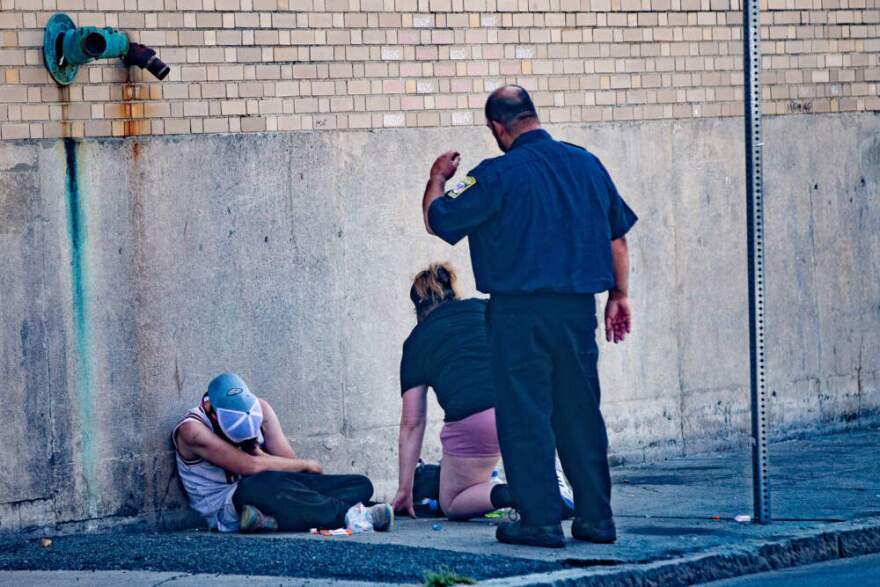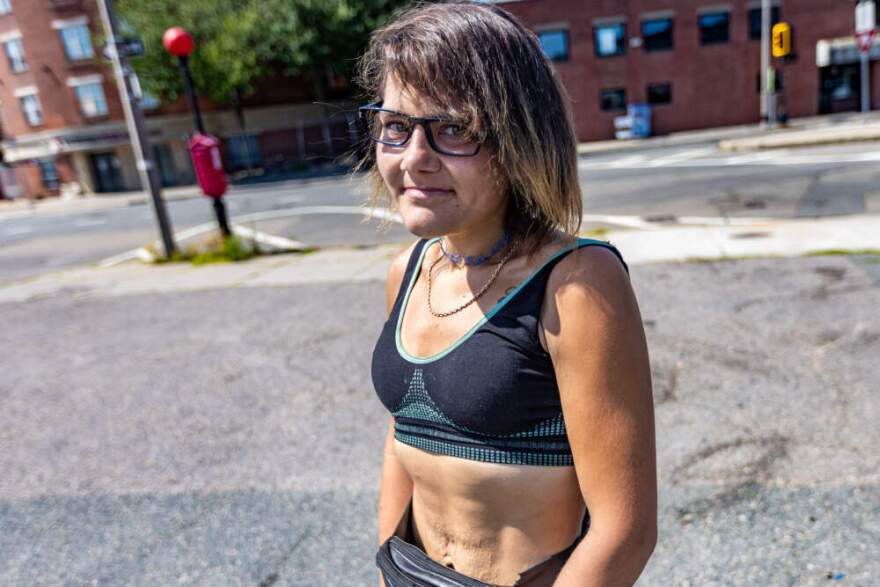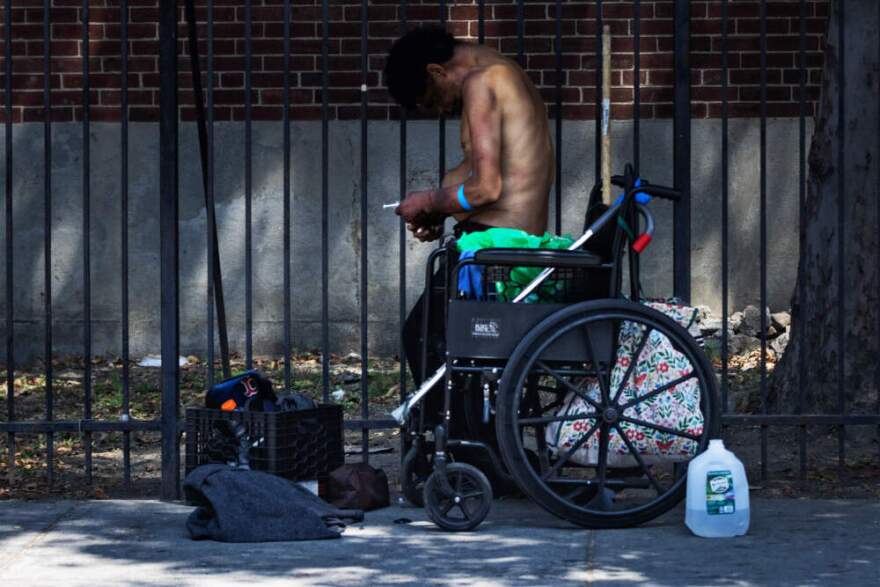The debate over how to deal with homelessness, drug addiction and mental health issues has intensified in recent months — with a renewed focus on a controversial strategy of forcing people into treatment.
The practice, known as civil commitment, has gained national prominence after President Trump issued an executive order in July embracing the approach.
Massachusetts has used involuntary commitment for decades. While some people say it helped them, state data calls into question its effectiveness more broadly. Many addiction treatment providers and some former patients say it’s inhumane and can even be harmful.
In Boston, some residents and workers in the South End, near the neighborhood long considered the epicenter of the region’s opioid epidemic, are calling for increased use of involuntary commitment. The streets around the intersection of Massachusetts Avenue and Melnea Cass Boulevard, or “Mass. and Cass,” were the site of drug use, drug dealing and a large tent encampment until city workers cleared it nearly two years ago. Now, residents say vandalism, drug use and related activity have scattered onto nearby blocks. They want city leaders to take tougher action, including forcing more people into treatment to curb substance use.
“People say that’s trampling on people’s civil rights,” said Sue Sullivan, a longtime neighborhood advocate and president and CEO of the Newmarket Business Improvement District, a group of businesses in the Mass. and Cass area. “We are not trampling on civil rights. We are giving people options to get better.”
Sullivan’s group pays for private security patrols to augment Boston and state police efforts, a well as transit police. During a recent visit, a few small groups of people congregated on sidewalks, especially near agencies offering services for homelessness, mental health and addiction. Police officers were visible outside these locations.
When he sees people hanging around, Mark Murphy, one of the security officers hired by Sullivan’s group, said he tells them to move along and stay off private property. He said he’s moved as many as 40 groups of people in a single day.

After two years on the job, Murphy knows many of the people he sees and said he often offers medical assistance or help contacting agencies that provide services. He estimates he’s used the nasal spray Narcan to reverse hundreds of overdoses. Sometimes Murphy described asking people if they’d like to call a loved one.
“I ask if they want to use my phone and maybe call their mom,” Murphy said. “I tell them, ‘Just say I miss you. I don’t need anything. I want you to know that I’m alive.’ ”
But neighbors say shuffling people from block to block is no solution; it only moves the problems around. They’ve called for increased police patrols and stronger measures against outdoor drug use. Their anger overflowed at a virtual community meeting last month.
“Our neighborhood is in a state of crisis,” South End resident Andy Brand said to attendees. “To the officials in this room, let me be clear: Your approach is not working. We warned you this would happen. We told you if you did not arrest drug dealers and get people into recovery the chaos would spread, and now it has.”
Boston police told the audience the department has civilly committed more than 50 people since mid-April. City officials said they’re improving street cleaning and needle collection, and touted new agreements with addiction treatment providers to get people admitted and transported quickly. They also said they are helping people on the streets reconnect with loved ones, and helping those families petition the courts for civil commitments.
More risk after involuntary commitment
More than half of states in the U.S. have laws allowing involuntary commitment for substance use. Massachusetts, which has used the practice since at least the 1980s, has one of the highest rates of involuntarily committing people to treatment in the country.
Under the state law known as Section 35, a family member or law enforcement officer can ask a judge to commit a person to addiction treatment. If a mental health professional hired by the court determines the person’s substance use poses an imminent risk of harm to themselves or others, a judge can send them to a secure facility for up to 90 days.
Some men who are civilly committed will be sent to treatment facilities in jails and prisons, even though they haven’t been charged with any crime. Researchers say Massachusetts is the only state in the country that allows this.
Currently, there are more than 600 beds for people civilly committed to treatment in Massachusetts, and more than half are in correctional institutions. The rest are overseen by the state’s departments of public health and mental health. In the last fiscal year, there were 2,758 civil commitments in the state, a slight decrease from the previous year, according to statistics from the state Bureau of Substance Abuse Services.
On the streets around Mass. and Cass, Kianna Pearson, 28, recalled being civilly committed a few years ago. She said it did little more than keep her inside for a few weeks, and there was no follow up care once she was released.
“The day I got out, I got high,” Pearson said, adding that she doesn’t think forcing people into treatment is effective.

“[If] they’re not ready, they’re not ready,” she said. “I overdosed like eight times in a week when I got out.”
Pearson said she frequently goes to Mass. and Cass to get the addiction medication methadone. She currently sleeps under a bridge in Boston and said she is still struggling. Her experience with involuntary commitment was so negative, she said, she’s preparing to stay outdoors, even in the upcoming winter months.
“People forget that we are some people’s aunts, brothers, mothers, fathers, sisters, cousins,” Pearson said. “These are human beings.”
There is little national data on the outcomes of involuntary commitment, but Massachusetts started collecting research on its Section 35 law after a state commission in 2019 recommended further evaluation. That research, along with a report issued last year by the state Department of Public Health, showed a higher risk of overdose and death after involuntary — versus voluntary — treatment. A state report with more current data is expected later this year.
“On the whole, we know that it’s not an effective tool, that it doesn’t work,” said Dr. Dave Munson, with Boston’s Health Care for the Homeless Program, who served on the Section 35 Commission. ”If we’re going to be making policy decisions or implementing policy that’s grounded in this, we should at least be aware of what we already know.”
Stronger rhetoric at the national level
The calls for more civil commitment mirror a national shift in policy on the opioid epidemic. The Trump administration has derided strategies known as “harm reduction,” which include providing clean needles and other supplies, and in some places allowing people to use drugs under supervision, while encouraging them to seek treatment, saying these approaches enable drug use. Instead, the White House has championed more punitive measures such as civil commitment.
That change in tone worries people like Sarah Porter, president and CEO of Victory Programs, which has offices in the Mass. and Cass area. The organization provides addiction treatment, mental health care and housing assistance to about 5,000 people a year.
“One of the things that’s really interesting to me is how close some of the president’s statements are to some of the statements I hear coming out of the South End of Boston,” Porter said.
Porter isn’t opposed to all civil commitments, and said she has seen first-hand how it can save some lives. But she thinks the focus should be on improving all types of addiction treatment. She said committing people may be a quick fix to clear streets, but is not an answer to the broader problem.
“Sometimes it is a lifesaving tool,” Porter said. “But a lifesaving tool and a solution to the problem are not the same thing.”
Some in local law enforcement are looking toward other potential solutions. Jim Borghesani, a spokesman for Suffolk County District Attorney Kevin Hayden, said involuntary treatment should only be used as a last resort. He said prosecutors know that steps such as improving long-term treatment and housing can be more effective.
“Section 35 was not intended as a measure to help clean up streets. It really wasn’t,” Borghesani said.
A show of force at Mass. and Cass
Boston officials have tried a variety of strategies at Mass. and Cass. In 2022, the city opened a $2 million engagement center where people could find showers, food, a respite from inclement weather and connections to services. But the center was shuttered after only about a year because of violence.
When Mayor Michelle Wu’s administration cleared the tent encampment, workers offered housing and other services to hundreds of people. While the tents have not returned, the neighbors’ complaints about drug use, vandalism and homelessness have become fodder for Wu’s opponents as she seeks re-election this year.
In February, city officials announced a new strategy of closer collaboration with law enforcement. They said the aim is to crack down on outdoor drug use and loitering. City leaders have asked outreach workers and volunteers not to distribute water or food outdoors, and to instead direct people to organizations that provide services.
Cassie Hurd, with the Material Aid and Advocacy Program, a nonprofit that works with people who are unhoused and use drugs, said many services are now available only inside offices — with police waiting by the doors.
“There is a big show of police force right now,” Hurd said.

The city has also established a new task force whose members include Sullivan, the business leader. She said the group is considering several options including what she calls a “recovery campus,” where people could stay for months and receive various levels of addiction and mental health treatment, housing and job training. City officials have long eyed Long Island in Boston Harbor for such a campus, but the effort is complex and costly, and likely to take years. The task force is expected to make its recommendations in six months.
“It is not acceptable for the quality of life of everyone that someone has to come out of their house with their children, and have someone shooting up in the neck on their front step,” Sullivan said.
But some critics say now is not the time to change strategies on addiction. Julie Burns, president and CEO of RIZE, a nonprofit working to end the opioid epidemic, points to dramatic declines in overdose deaths in Boston and nationally as proof that the current efforts were helping stem the loss of life.
“I certainly understand the increased anger, but I think we also need to look at the decreased overdose rates that we’re seeing in Boston and really reflect on the fact that a lot of what has been happening is working,” Burns said. “We can’t throw that out to pursue a strategy that may not have results.”
This article was originally published on WBUR.org.
Copyright 2025 WBUR







